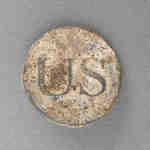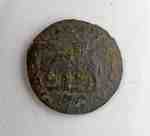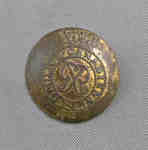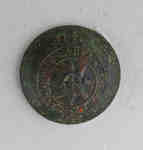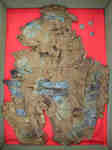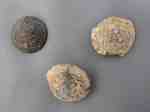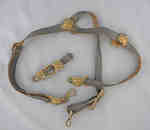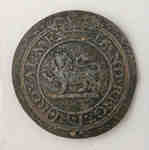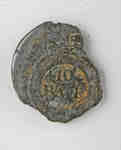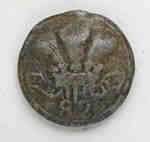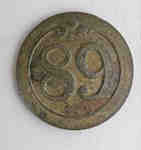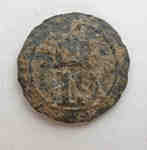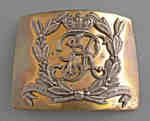Results
- This is a United States Infantry (general service) button. The letters “US” are raised in the center and this metal button measures 2 cm in diameter. This item is on display at the Battleground HotelThis is a United States Infantry (general service) button. The letters “US” …
- This is a button from the 76th Hindoostan Regiment that is believed to have served on the Niagara Frontier and at Plattsburg (September 11,1814) during the War of 1812-1814. The button has a raised dThis is a button from the 76th Hindoostan Regiment that is believed …
- This is a Quebec Milice Canadienne button that measures 1.5 cm in diameter. There is a crown on top with a belt design used in the reign of George IV that has “MILICE CANADIENNE” spelt out inside. ThThis is a Quebec Milice Canadienne button that measures 1.5 cm in …
- These are 41st Regiment Gaiter Buttons that plain except for the raised “41” in the centre. This regiment served in Canada during the War of 1812-1814.These are 41st Regiment Gaiter Buttons that plain except for the raised …
- Button has three raised cannon balls in a horizontal row across the top and three raised cannons in a vertical row that are set in a shield. It is believed that this button is from the War of 1812. DButton has three raised cannon balls in a horizontal row across the …
- Has a raised crown on the top and a raised 93 below. This button, believed to be from the 1812 era, is slightly corroded around the outside edge. The diameter is 1.4 cm.Has a raised crown on the top and a raised 93 below. …
- This is a cloth fragment of a uniform worn by a soldier of the 89th Regiment at the Battle of Lundy’s Lane. It was discovered in a trench on Lundy’s Lane on Sept. 3, 1891. There are also three regimeThis is a cloth fragment of a uniform worn by a soldier …
- A British infantry regiment that was raised in 1751 and amalgamated with the 52nd (Oxfordshire) Regiment of Foot, to form the Oxfordshire and Buckinghamshire Light Infantry in 1881. It is believed thA British infantry regiment that was raised in 1751 and amalgamated with …
- This is a sword belt made of black leather with five large brass lion heads and four smaller lion heads on the buckles.This is a sword belt made of black leather with five large …
- A uniform button of the Royal Newfoundland Regiment. There is a raised design of a lion in the center standing on a length of cord with one leg pointed upward. There is also a crown at the top and thA uniform button of the Royal Newfoundland Regiment. There is a raised …
- A button from the 10th Royal Veteran Battalion. In the center is a band of fine circular lines that surround the number “10” with “RV” below it. There is also a crown that tops the circle. This buttoA button from the 10th Royal Veteran Battalion. In the center is …
- This is an 82nd Regiment of Foot, Prince of Wales Volunteers button. There is a raised design of three feather-like plumes tied together with a scroll and “82” raised below. The button is made of metThis is an 82nd Regiment of Foot, Prince of Wales Volunteers button. …
- This is the uniform button of the 89th Regiment of Foot, the Royal Irish Fusiliers. There is a raised “89” in the centre with a fine raised line around it that ends at the top where a dot is. This buThis is the uniform button of the 89th Regiment of Foot, the …
- This 19th Light Dragoons button has a raised fine line circle around a centered “19” with a crown on top. A squadron was stationed on the Niagara Frontier and took part in the capture of Black Rock aThis 19th Light Dragoons button has a raised fine line circle around …
- The design is a raised “66” below a raised crown within a thin lined circle. Although this regiment was not in Niagara during the War of 1812-1814 this button was used by the regiment up until the 18The design is a raised “66” below a raised crown within a …
- This is a button from the 41st Regiment of Foot that served in the Canada during the War of 1812. The design is a “41” raised in the center of an eight point star. This item can be found at the BattlThis is a button from the 41st Regiment of Foot that served …
- Accession Numbers: 986.D.098.052 986.D.098.053 986.D.098.054 986.D.098.055 986.D.098.056Accession Numbers: 986.D.098.052 986.D.098.053 986.D.098.054 986.D.098.055 986.D.098.056
- This is a brass belt buckle that was found in the town of Niagara. It is believed to have belonged to a member of the British light infantry or regular troops because of the lion’s head decoration. FThis is a brass belt buckle that was found in the town …
- This plate is believed to have been used between 1796 and 1828 for a Heavy Cavalry Officers’ waist belt. It is gilt with a silver crest that has “GR” in the centre, with a Hanoverian crown on top, anThis plate is believed to have been used between 1796 and 1828 …
When selecting an individual record or object, you will move
to the website of the heritage institution that houses the item.
To return to the search or results pages, select "Back", "Results" or "New Search".
 This project was made possible with the support of the Department of Canadian Heritage
This project was made possible with the support of the Department of Canadian Heritage
through the Canadian Culture Online Strategy.
to the website of the heritage institution that houses the item.
To return to the search or results pages, select "Back", "Results" or "New Search".
 This project was made possible with the support of the Department of Canadian Heritage
This project was made possible with the support of the Department of Canadian Heritage through the Canadian Culture Online Strategy.






